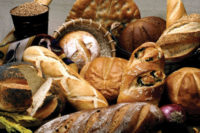
|
The Whole Grains Summit was recently held in Minneapolis, and I was thrilled to have the opportunity to attend. Organized by the Grains for Health Foundation, the intended purpose for the summit was to develop a strategic plan for research, integration, communication and implementation to advance consumption of whole grains. It was an especially enjoyable conference because it opened the door for discussion on the industry’s most pressing issues between whole-grain experts from all corners of the world.
To be certain, discussion at the summit was largely centered on efforts to establish a whole-grain food definition. In fact, Grain Foods Foundation advisory board member Julie Jones, Ph.D., gave a presentation on this topic, and she made clear the many needs of a strong definition. Such needs include a definition that’s internationally acceptable, fair to the industry and consumers and measurable for proper regulation. Jones stated the importance of a whole-grain food definition (and communications around it) should be to reduce consumer confusion about whole grains, which can stem from factors as basic as color, texture and even an unfamiliar name.
Naturally, establishing a whole-grain food definition would imply the reformulation of any number of grain products, and multiple representatives of the food industry discussed considerations surrounding this topic. For example, Beth Arndt, Ph.D. of ConAgra, highlighted that beyond meeting a criterion for whole-grain content, product formulators must consider sodium and sugar levels, food labeling, other nutrition/health trends, food safety, cost and, of course, taste. The real takeaway message was that this is not a simple process, which is why collaboration across the industry is so necessary.
The research presented at the Whole Grains Summit has key implications for our industry’s products. Beyond settling on a definition for “whole-grain food” and the implied reformulation, we need to consider strategies for increasing intake. According to Dietary Guidelines for Americans data, the average American consumes less than one (1-oz.) serving of whole grains daily (2006 data), despite our recommendation to “make half your grains whole.”
Meeting this recommendation translates to three servings a day for a 2,000-calorie diet. And while wheat is the largest source of whole grain in the American diet, people are not consuming nearly enough of it in whole-grain form.
Looking at this through a global lens, researcher Anne Nugent from Ireland’s University College Dublin asserted that 6-33% of people worldwide consume no whole grains at all.
As we all know, whole grains provide vital nutrients for good health. They have been shown to reduce the risk of obesity, certain cancers and heart disease, so increasing intake is a key step for improving public health. With that said, I was encouraged by the recent findings released in the International Food Information Council Foundation’s 2012 Food & Health Survey that indicated that in the last year 75% of consumers have made at least some effort to eat more whole grains.
This coming fall, we’ll be hard at work educating consumers about the importance of making “half of your grains whole.” As part of the MyPlate Nutrition Communicators Network, we and other members of the grains industry are busy planning for the September to December promotion of this consumer message. We are excited about the timing, because back-to-school and the holidays are perfect occasions for reminding influencers and consumers alike about the role of whole (and enriched) grains in a healthful diet. We look forward to sharing updates with you on the progress of these programs later this year. SF&WB






